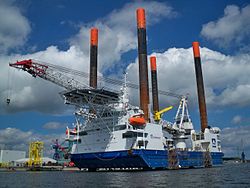Thor (ship)
|
Thor during the renovation in Wilhelmshaven (2013)
|
||||||||||||||||
|
||||||||||||||||
|
||||||||||||||||
|
||||||||||||||||
|
||||||||||||||||
|
||||||||||||||||
|
||||||||||||||||
The Thor is a work ship built for the installation of wind turbines (WEA) in offshore wind farms . The ship was a jack-up rig built and was later replaced by retrofitting a diesel-electric drive to a construction vessel .
history
The Thor was built in 2009/2010 under construction number 1110 at the Crist shipyard in Gdynia . The hull was supplied by Stocznia Gdynia. The keel was laid on March 23, 2009, the launch on July 13, 2009. It was completed on May 14, 2010. The construction of the jack-up platform cost around EUR 75 million.
The Thor was initially owned by HGO InfraSea Solutions.
commitment
The ship had been in service in the North Sea since May 2010 . It was initially chartered for the construction of the offshore wind farm BARD Offshore 1 .
With the legs raised, the jack-up platform was moved by tugs to the desired position, where the legs were then lowered. By absorbing ballast water and raising the platform above sea level, pressure is put on the legs. This creates a platform that is firmly connected to the seabed. The legs sink about two meters into the sediment on the sea floor. It takes three hours to gradually extend your legs. The Thor was towed to the base port as rarely as possible. The wind turbine components were delivered by ship and taken on deck by crane.
From February 2013 the Thor was intended for the installation of the wind turbine in the OWP Global Tech I , but could only fulfill this purpose from September. With the retrofitted drive, loaded with tower segments, turbines and rotors from the wind turbines, it was able to commute around 100 kilometers from the base port to the Global Tech I wind farm construction site.
Technical data and equipment
Each of the four legs is 82 meters long and weighs 530 tons. At each foot there is a plate with a diameter of over eight meters so that the legs do not sink so much into the sediment on the seabed. When fully loaded, the Thor can weigh up to 10,000 tons.
There are two cranes on board. The boom of the Liebherr heavy-duty crane is 87 meters long. With a reach of 15 meters, it can lift up to 500 tons. The second crane is a smaller working crane on deck. It can lift up to 4 tons with a reach of 20 meters. A helicopter landing platform is located above the superstructure at the bow . There is accommodation for 48 people on board.
Until the beginning of 2013, the Thor only had a rudder propeller for maneuvering at all four corners, each driven by an electric motor with an output of 750 kW.
In 2013, the ship in the Kaiserhafen in Bremerhaven was converted into an installation ship and provided with its own drive. For this purpose, the configuration of the propeller pods was changed. Two of the existing propeller pods were removed and replaced by two new propeller pods. The new propeller pods are driven by electric motors with an output of 2560 kW each. For the generation of the two new azimuth thruster generators were installed by two MTU - Diesel engines of the type 16V4000M73 are driven. Five generators powered by Cummins engines and an emergency generator, also powered by a Cummins engine, are available to generate electricity for the other two propeller pods and to supply the on-board network . Motors of the type KTA50-D (M1) (three pieces), KTA38-D (M1) (one piece) and KTA19-D (M1) (two pieces, one of which for driving the emergency generator) were used.
literature
- Hochtief Construction AG: Thor jack-up platform , description and technical data, Civil Engineering and Marine Works
- Mathias Sorgatz: The positioning of jack-up platforms with their own drive . In: Schiff & Hafen , issue 11/2012, pp. 66–68, Seehafen-Verlag, Hamburg 2012, ISSN 0938-1643 , report from the captain of Thor
Web links
Individual evidence
- ^ Jack-up rigs "Thor": Offshore industry tends towards size , VerkehrsRundschau, May 10, 2010.
- ↑ "Thor" is supposed to avoid bottlenecks in wind farm construction , Die Welt , May 6, 2010.
- ↑ The floating crane with the giant legs , Die Zeit , June 7, 2011.
- ↑ First AREVA wind turbines on the way to the construction site , globaltechone.de, September 4, 2013, accessed on December 25, 2013.
- ^ THB - Deutsche Schiffahrts-Zeitung of January 24, 2013, p. 15.
- ^ DP2 Thor , DEME Group.
- ↑ Wolfgang Stolba: Heavenly Forces , Rolls-Royce Power Systems, March 29, 2013.
- ↑ Thor , Scheepvaartwest.
